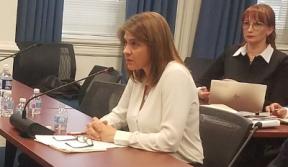The movement for green jobs has, of course, garnered a lot of
attention and interest from environmentalists and rank-and-file union members
across the country. The Blue Green Alliance has been bringing together
United Steelworkers, the Sierra Club, CWA, NRDC, LIUNA and the SEIU for years
to fight for "good jobs, a clean environment and a green
economy." The AFL-CIO has also established a Center for Green Jobs. SEIU's Anna Burger joined Secretary of Labor Hilda Solis today for a roundtable event focused on ensuring that women workers benefit from the green economy. Environmental groups are also playing a very important role in advocating for the Employee Free Choice Act which is the labor movement's top legislative priority and would help to grow the labor movement in the US. It has been reported that the Sierra Club also helped the UE workers at Republic Windows in Chicago find a new buyer for their factory. There are also other
interesting examples of labor-environmental collaboration that have not
received as much attention.
Earlier this month, socially responsible investors combined environmental
and labor concerns and successfully got McDonald's to agree to take steps
to reduce pesticide use. The initial agreement focuses on McDonald's
potato supply chain and will help protect the environment as well as the health
of workers who are harmed by their close contact with toxic chemicals.
Today, the AFL-CIO also announced a new plan to reduce energy consumption,
cut down waste and reduce the carbon footprint of its national headquarters.
The Rainforest Action
Network has included demands to protect worker rights in their rainforest agribusiness campaign. The campaign is focused on how US
agribusiness companies like Cargill, Archer Daniels Midland and Bunge are
rapidly expanding soy and palm oil plantations which is leading to deforestation. RAN has also demanded that these companies stop abusing workers and has backed up their commitment with actual action -- for example, in e-mail actions related to palm oil expansion in Indonesia.
ILRF has worked with environmental organizations in promoting sustainability in the cocoa industry. For example, we recently did a press release with the Organic Consumers Association in response to Mars' recent announcement related to their cocoa sourcing policies. OCA followed up by launching an e-mail action to Mars calling on the company to support fair trade AND organic certification in order to protect both workers and the environment. The Stop Firestone campaign also includes both labor and environmental demands. As part of our work to end forced child labor in cotton production in Uzbekistan, we have also worked with the Environmental Justice Foundation in the UK.
On a global level, the International Trade Union Confederation, as well as many local and national trade unions, have attended important environmental conferences and are putting forward proposals for climate change policies from a worker rights perspective. This document from the ITUC outlines some of their positions of climate change and this document includes concrete proposals. The new report from Global Unions and the ITUC titled "Getting the World to Work: Global Union Strategies for Recovery" also includes ideas for how to protect workers and the environment in global responses to the economic crisis.
These are just a few examples of how the labor and environmental movements are working together for a better world. I hope that this type of joint work continues because the combined power of these movements has the potential to lead to major changes. Do you know of other examples of successful collaborations for environmental and economic justice?

